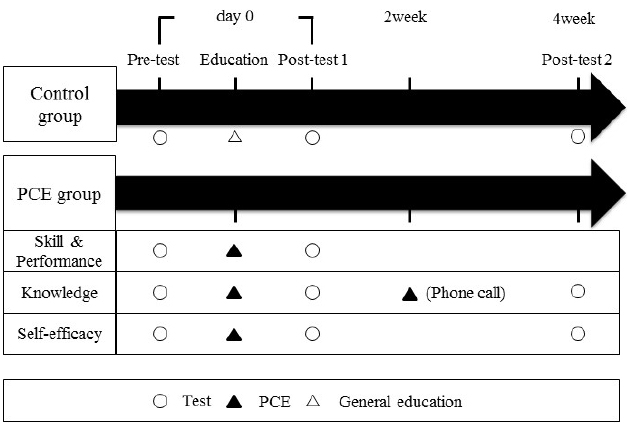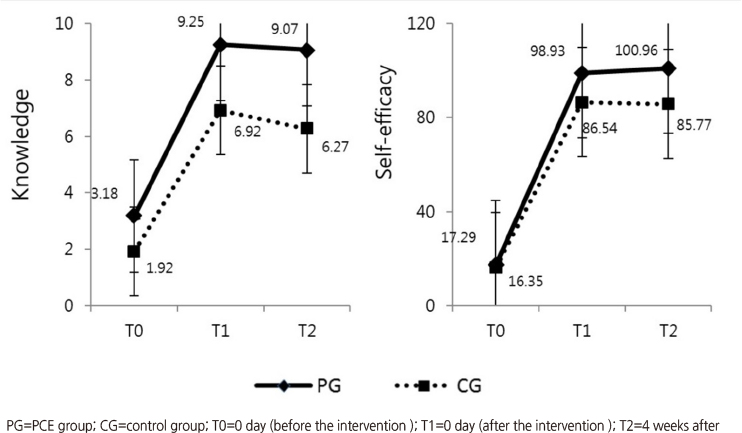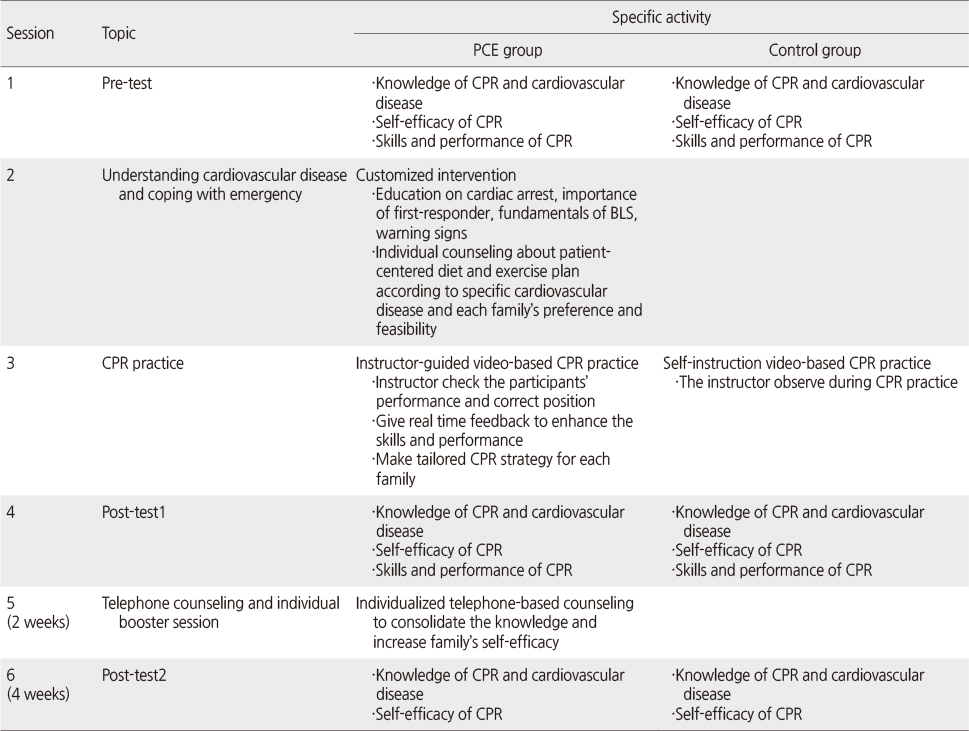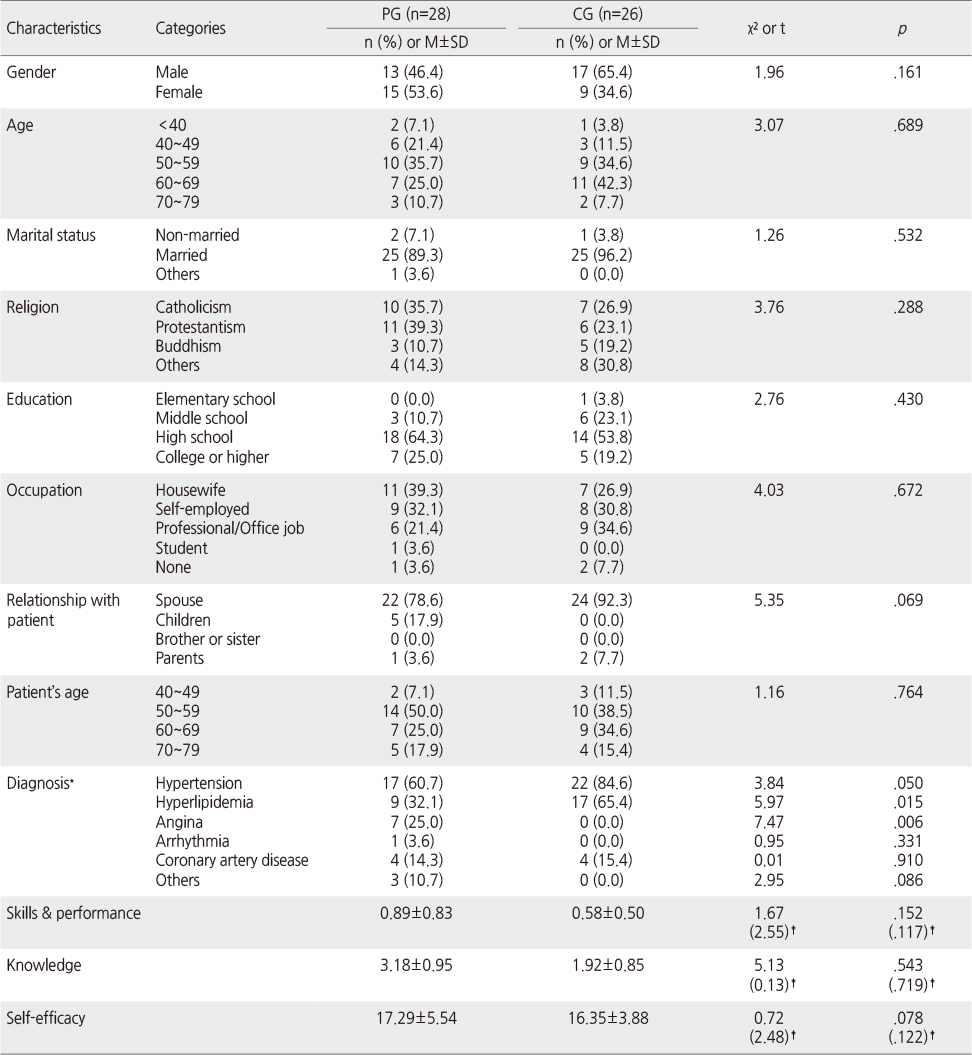Articles
- Page Path
- HOME > J Korean Acad Nurs > Volume 46(3); 2016 > Article
-
Original Article
- The Effect of Patient-centered CPR Education for Family Caregivers of Patients with Cardiovascular Diseases
- Hyun Sun Kim, Hyun-Jin Kim, Eunyoung E. Suh
-
Journal of Korean Academy of Nursing 2016;46(3):463-474.
DOI: https://doi.org/10.4040/jkan.2016.46.3.463
Published online: June 30, 2016
1College of Nursing and Research Institute of Nursing Science, Seoul National University, Seoul, Korea.
2Department of Cardiology, Myongji Hospital, Seoul, Korea.
3Department of Translational Medicine, College of Medicine, Seoul National University, Seoul, Korea.
- Address reprint requests to: Suh, Eunyoung E. College of Nursing, Seoul National University, 103 Daehackro, Jonrogu, Seoul 06080, Korea. Tel: +82-2-740-8484, Fax: +82-2-740-8484, esuh@snu.ac.kr
© 2016 Korean Society of Nursing Science
This is an Open Access article distributed under the terms of the Creative Commons Attribution NoDerivs License. (http://creativecommons.org/licenses/by-nd/4.0/) If the original work is properly cited and retained without any modification or reproduction, it can be used and re-distributed in any format and medium.
Abstract
-
Purpose
- For cardiovascular patients, family caregivers play a vital role in daily nursing and cardiac emergencies. This study aimed to evaluate the effect of patient-centered CPR education (PCE) for family caregivers of patients with cardiovascular diseases.
-
Methods
- Fifty-four participants were randomly assigned to the PCE or control group. The PCE group received tailored counseling on overall cardiovascular disease information and CPR followed by interactive instructor-guided CPR training and re-education follow-up by telephone 2 weeks later. The control group received only video-based CPR self-education and booklets. Cardiovascular disease and CPR knowledge and self-efficacy were measured before (pre-test), immediately after (post-test 1), and 4 weeks after the PCE (post-test 2). CPR skills and performance were measured pre-test and at post-test1.
-
Results
- The PCE group demonstrated significant improvements in knowledge (F=91.09, p<.001), self-efficacy (F=15.19, p<.001) and CPR skills and performance (F=8.10, p=.008), as well as significant differences over time (knowledge: F=364.25, p<.001; self-efficacy: F=1162.28, p<.001; CPR skills and performance: F=1798.81, p<.001). There were significant group-by-time interactions for knowledge (F=8.10, p=.001), self-efficacy (F=4.30, p=.019) and CPR skills and performance (F=4.81, p=.036) by repeated measures ANOVA.
-
Conclusion
- This is the first study to demonstrate the effects of a patient-centered intervention with CPR education tailored for patients' and family caregivers' preferences, needs, and lifestyles. The results of this study encourage the use of tailored, patient-centered interventions in cardiovascular nursing practice.
INTRODUCTION
METHODS
1) PCE Group
2) Control Group
RESULTS
DISCUSSION
CONCLUSION
Acknowledgments
ACKNOWLEDGEMENTS
This work was supported by the National Research Foundation of Korea (NRF) grant funded by the Korea government (Ministry of Science, ICT, and Future Planning) (NRF-2013R1A2A2A01006176).
The authors declared no conflict of interest.
- 1. McNally B, Robb R, Mehta M, Vellano K, Valderrama AL, Yoon PW, et al. Out-of-hospital cardiac arrest surveillance-cardiac arrest registry to enhance survival (CARES), United States, October 1, 2005-December 31, 2010. MMWR Surveill Summ. 2011;60(SS08):1–19.
- 2. Park IS, Kim EJ, Sohn HS, Kang SH. Factors influencing the return of spontaneous circulation of patients with out-of-hospital cardiac arrest. J Digit Policy Manag. 2013;11(9):229–238.
- 3. Iwami T, Kawamura T, Hiraide A, Berg RA, Hayashi Y, Nishiuchi T, et al. Effectiveness of bystander-initiated cardiac-only resuscitation for patients with out-of-hospital cardiac arrest. Circulation. 2007;116(25):2900–2907. ArticlePubMed
- 4. Dracup K, Moser DK, Taylor SE, Guzy PM. The psychological consequences of cardiopulmonary resuscitation training for family members of patients at risk for sudden death. Am J Public Health. 1997;87(9):1434–1439. ArticlePubMedPMC
- 5. Kliegel A, Scheinecker W, Sterz F, Eisenburger P, Holzer M, Laggner AN. The attitudes of cardiac arrest survivors and their family members towards CPR courses. Resuscitation. 2000;47(2):147–154. ArticlePubMed
- 6. Swor R, Khan I, Domeier R, Honeycutt L, Chu K, Compton S. CPR training and CPR performance: Do CPR-trained bystanders perform CPR? Acad Emerg Med. 2006;13(6):596–601. ArticlePubMed
- 7. Niklasson C, Bohm K. Attitudes towards bystander cardiopulmonary resuscitation (CPR) among laypersons with and without CPR training. Resuscitation. 2015;96:Suppl 1. 59ArticlePubMed
- 8. Lim S. CPR for saving their family. Korean Association of Cardio-Pulmonary Resuscitation Newsletter; 2015.9(1): p. 4–5.
- 9. Lee MH, Choi SH, Park MJ. Effect of CPR training for lay trainees on their knowledge and attitudes. J Korean Acad Fundam Nurs. 2007;14(2):198–203.
- 10. Kim SM, Lee EJ. The effects of CPR clinical training on CPR performance and self efficacy in nursing students. J Korea Acad Ind Coop Soc. 2011;12(12):5759–5765. Article
- 11. Shaller D. Patient-centred care: What does it take?. Oxford, UK: Picker Institute and The Commonwealth Fund; 2007.
- 12. Epstein RM, Street RL Jr. The values and value of patient-centered care. Ann Fam Med. 2011;9(2):100–103. ArticlePubMedPMC
- 13. Hilgeman MM, Allen RS, Snow AL, Durkin DW, DeCoster J, Burgio LD. Preserving identity and planning for advance care (PIPAC): Preliminary outcomes from a patient-centered intervention for individuals with mild dementia. Aging Ment Health. 2014;18(4):411–424. ArticlePubMed
- 14. Jayadevappa R, Chhatre S. Patient centered care: A conceptual model and review of the state of the art. Open Health Serv Policy J. 2011;4:15–25. Article
- 15. Cohen J. Statistical power analysis for the behavioral sciences. New York, NY: Academic Press; 1977.
- 16. Kromann CB, Bohnstedt C, Jensen ML, Ringsted C. The testing effect on skills learning might last 6 months. Adv Health Sci Educ Theory Pract. 2010;15(3):395–401. ArticlePubMedPDF
- 17. Taylor K. Paternalism, participation and partnership - The evolution of patient centeredness in the consultation. Patient Educ Couns. 2009;74(2):150–155. ArticlePubMed
- 18. Korean Association of CardioPulmonary Resuscitation. CPR guideline in Korea 2011 [Internet]. Seoul, Ministry of Health & Welfare, National Medical Center, National Emergency Medical Center, Korean Association of CardioPulmonary Resuscitation. 2011;cited 2015 November 25. Available from: http://www.kacpr.org/popup/file/2011_guidelines.pdf
- 19. Park JM. The effectiveness of competency and retention in cardiopulmonary resuscitation through self-directed learning [dissertation]. Daegu, Kyungpook National University. 2006;1–69.
- 20. Kim KS. Medical surgical nursing. Paju: Soomoosa; 2013.
- 21. Schlessel JS, Rappa HA, Lesser M, Pogge D, Ennis R, Mandel L. CPR knowledge, self-efficacy, and anticipated anxiety as functions of infant/child CPR training. Ann Emerg Med. 1995;25(5):618–623. ArticlePubMed
- 22. Leone RP, Walker CA, Curry LC, Agee EJ. Application of a marketing concept to patient-centered care: Co-producing health with heart failure patients. Online J Issues Nurs. 2012;17(2):7. Article
- 23. Buckley T, McKinley S, Gallagher R, Dracup K, Moser DK, Aitken LM. The effect of education and counselling on knowledge, attitudes and beliefs about responses to acute myocardial infarction symptoms. Eur J Cardiovasc Nurs. 2007;6(2):105–111. ArticlePubMedPDF
- 24. Dudas K, Olsson LE, Wolf A, Swedberg K, Taft C, Schaufelberger M, et al. Uncertainty in illness among patients with chronic heart failure is less in person-centred care than in usual care. Eur J Cardiovasc Nurs. 2013;12(6):521–528. ArticlePubMedPDF
- 25. Boyne JJ, Vrijhoef HJ, Spreeuwenberg M, De Weerd G, Kragten J, Gorgels AP. Effects of tailored telemonitoring on heart failure patients' knowledge, self-care, self-efficacy and adherence: A randomized controlled trial. Eur J Cardiovasc Nurs. 2014;13(3):243–252. ArticlePubMedPDF
- 26. Holst M, Willenheimer R, Martensson J, Lindholm M, Stromberg A. Telephone follow-up of self-care behaviour after a single session education of patients with heart failure in primary health care. Eur J Cardiovasc Nurs. 2007;6(2):153–159. ArticlePubMedPDF
- 27. Bekelman DB, Plomondon ME, Carey EP, Sullivan MD, Nelson KM, Hattler B, et al. Primary results of the patient-centered disease management (PCDM) for heart failure study: A randomized clinical trial. JAMA Intern Med. 2015;175(5):725–732. ArticlePubMed
- 28. Boyde M, Turner C, Thompson DR, Stewart S. Educational interventions for patients with heart failure: A systematic review of randomized controlled trials. J Cardiovasc Nurs. 2011;26(4):E27–E35. PubMed
- 29. Mpotos N, Yde L, Calle P, Deschepper E, Valcke M, Peersman W, et al. Retraining basic life support skills using video, voice feedback or both: A randomised controlled trial. Resuscitation. 2013;84(1):72–77. ArticlePubMed
- 30. Hamilton R. Nurses' knowledge and skill retention following cardiopulmonary resuscitation training: A review of the literature. J Adv Nurs. 2005;51(3):288–297. ArticlePubMed
REFERENCES
Figure & Data
REFERENCES
Citations

- Mastering the Art of Caregiving: Instructional Approaches to Teaching Healthcare‐Related Procedural Skills to Informal Caregivers—An Integrative Review
An Ling Siew, Esther Yin Hui Chew, Ee‐Yuee Chan, Elaine Kee Chen Siow
Journal of Advanced Nursing.2025;[Epub] CrossRef - Effect of tailored cardiopulmonary resuscitation training for middle-aged and older adults with visual impairment: A cluster-randomized controlled trial
Eunjin Yang, Kyung Hee Lee, Youngshin Joo
Disability and Health Journal.2025; 18(4): 101909. CrossRef - Basic life support training targeted to family members or carers of those at high-risk of out-of-hospital cardiac arrest: a systematic review
Zakary Doherty, Janet E. Bray, Judith Finn, Susie Cartledge
Resuscitation Plus.2025; 25: 101031. CrossRef - Education, Implementation, and Teams: 2025 International Liaison Committee on Resuscitation Consensus on Science With Treatment Recommendations
Robert Greif, Adam Cheng, Cristian Abelairas-Gómez, Katherine S. Allan, Jan Breckwoldt, Andrea Cortegiani, Aaron J. Donoghue, Kathryn J. Eastwood, Barbara Farquharson, Ming-Ju Hsieh, Tracy Kidd, Ying-Chih Ko, Kasper G. Lauridsen, Yiqun Lin, Andrew S. Lock
Circulation.2025;[Epub] CrossRef - Education, Implementation, and Teams: 2025 International Liaison Committee on Resuscitation Consensus on Science With Treatment Recommendations
Robert Greif, Adam Cheng, Cristian Abelairas-Gómez, Katherine S. Allan, Jan Breckwoldt, Andrea Cortegiani, Aaron J. Donoghue, Kathryn J. Eastwood, Barbara Farquharson, Ming-Ju Hsieh, Tracy Kidd, Ying-Chih Ko, Kasper G. Lauridsen, Yiqun Lin, Andrew S. Lock
Resuscitation.2025; 215: 110807. CrossRef - 2022 International Consensus on Cardiopulmonary Resuscitation and Emergency Cardiovascular Care Science With Treatment Recommendations: Summary From the Basic Life Support; Advanced Life Support; Pediatric Life Support; Neonatal Life Support; Education, I
Myra H. Wyckoff, Robert Greif, Peter T. Morley, Kee-Chong Ng, Theresa M. Olasveengen, Eunice M. Singletary, Jasmeet Soar, Adam Cheng, Ian R. Drennan, Helen G. Liley, Barnaby R. Scholefield, Michael A. Smyth, Michelle Welsford, David A. Zideman, Jason Acwo
Pediatrics.2023;[Epub] CrossRef - Expert opinion on evidence after the 2020 Korean Cardiopulmonary Resuscitation Guidelines: a secondary publication
Sung Phil Chung, Youdong Sohn, Jisook Lee, Youngsuk Cho, Kyoung-Chul Cha, Ju Sun Heo, Ai-Rhan Ellen Kim, Jae Guk Kim, Han-Suk Kim, Hyungoo Shin, Chiwon Ahn, Ho Geol Woo, Byung Kook Lee, Yong Soo Jang, Yu Hyeon Choi, Sung Oh Hwang
Clinical and Experimental Emergency Medicine.2023; 10(4): 382. CrossRef - Application of the Modified Basic Life Support Training Model in Improving Community Residents’ Rescue Willingness in Nantong City in China
Yu-Fei Qian, Yu-Qin Ren, Li Wang, Rong-Qian Sun, Dan-Feng Li, Samar Tharwat
International Journal of Clinical Practice.2022;[Epub] CrossRef - 2021 International Consensus on Cardiopulmonary Resuscitation and Emergency Cardiovascular Care Science With Treatment Recommendations: Summary From the Basic Life Support; Advanced Life Support; Neonatal Life Support; Education, Implementation, and Teams
Myra H. Wyckoff, Eunice M. Singletary, Jasmeet Soar, Theresa M. Olasveengen, Robert Greif, Helen G. Liley, David Zideman, Farhan Bhanji, Lars W. Andersen, Suzanne R. Avis, Khalid Aziz, Jason C. Bendall, David C. Berry, Vere Borra, Bernd W. Böttiger, Richa
Circulation.2022;[Epub] CrossRef - 2022 International Consensus on Cardiopulmonary Resuscitation and Emergency Cardiovascular Care Science With Treatment Recommendations: Summary From the Basic Life Support; Advanced Life Support; Pediatric Life Support; Neonatal Life Support; Education, I
Myra H. Wyckoff, Robert Greif, Peter T. Morley, Kee-Chong Ng, Theresa M. Olasveengen, Eunice M. Singletary, Jasmeet Soar, Adam Cheng, Ian R. Drennan, Helen G. Liley, Barnaby R. Scholefield, Michael A. Smyth, Michelle Welsford, David A. Zideman, Jason Acwo
Resuscitation.2022; 181: 208. CrossRef - 2022 International Consensus on Cardiopulmonary Resuscitation and Emergency Cardiovascular Care Science With Treatment Recommendations: Summary From the Basic Life Support; Advanced Life Support; Pediatric Life Support; Neonatal Life Support; Education, I
Myra H. Wyckoff, Robert Greif, Peter T. Morley, Kee-Chong Ng, Theresa M. Olasveengen, Eunice M. Singletary, Jasmeet Soar, Adam Cheng, Ian R. Drennan, Helen G. Liley, Barnaby R. Scholefield, Michael A. Smyth, Michelle Welsford, David A. Zideman, Jason Acwo
Circulation.2022;[Epub] CrossRef - Clinicians for CARE: A Systematic Review and Meta‐Analysis of Interventions to Support Caregivers of Patients With Heart Disease
Kellen A. Knowles, Helen Xun, Sunyoung Jang, Sharon Pang, Charles Ng, Apurva Sharma, Erin M. Spaulding, Rohanit Singh, Alaa Diab, Ngozi Osuji, Joshua Materi, Danielle Amundsen, Shannon Wongvibulsin, Daniel Weng, Pauline Huynh, Julie Nanavati, Jennifer Wol
Journal of the American Heart Association.2021;[Epub] CrossRef - Effectiveness of the Family and Friends CPR course in learning cardiopulmonary resuscitation in relatives of patients with high cardiovascular risk or who have suffered a cardiovascular event
Bruno Enzo Vargas-Sánchez, Miluska Madeleine Salazar-Arteaga, Aida Del Carmen Rotta-Rotta, Roy Germán Dueñas-Carbajal
Iberoamerican Journal of Medicine.2021; 3(4): 307. CrossRef - 2021 International Consensus on Cardiopulmonary Resuscitation and Emergency Cardiovascular Care Science With Treatment Recommendations
Myra H. Wyckoff, Eunice M. Singletary, Jasmeet Soar, Theresa M. Olasveengen, Robert Greif, Helen G. Liley, David Zideman, Farhan Bhanji, Lars W. Andersen, Suzanne R. Avis, Khalid Aziz, Jason C. Bendall, David C. Berry, Vere Borra, Bernd W. Böttiger, Richa
Resuscitation.2021; 169: 229. CrossRef - The impact of bystander cardiopulmonary resuscitation on patients with out-of-hospital cardiac arrests
Fang-Yu Liou, Kun-Chang Lin, Chian-Shiu Chien, Wan-Ting Hung, Yi-Ying Lin, Yi-Ping Yang, Wei-Yi Lai, Tzu-Wei Lin, Shu-Hung Kuo, Wei-Chun Huang
Journal of the Chinese Medical Association.2021; 84(12): 1078. CrossRef - Formación de población adulta lega en soporte vital básico. Una revisión sistemática
Violeta González-Salvado, Emilio Rodríguez-Ruiz, Cristian Abelairas-Gómez, Alberto Ruano-Raviña, Carlos Peña-Gil, José Ramón González-Juanatey, Antonio Rodríguez-Núñez
Revista Española de Cardiología.2020; 73(1): 53. CrossRef - Training adult laypeople in basic life support. A systematic review
Violeta González-Salvado, Emilio Rodríguez-Ruiz, Cristian Abelairas-Gómez, Alberto Ruano-Raviña, Carlos Peña-Gil, José Ramón González-Juanatey, Antonio Rodríguez-Núñez
Revista Española de Cardiología (English Edition).2020; 73(1): 53. CrossRef - Targeting relatives: Impact of a cardiac rehabilitation programme including basic life support training on their skills and attitudes
Violeta González-Salvado, Cristian Abelairas-Gómez, Francisco Gude, Carlos Peña-Gil, Carmen Neiro-Rey, José Ramón González-Juanatey, Antonio Rodríguez-Núñez
European Journal of Preventive Cardiology.2019; 26(8): 795. CrossRef


Figure 1
Figure 2
Summary of the Patient-centered CPR Education (PCE)
Homogeneity Test of Family Caregivers' Characteristics (N=54)
*Multiple selection; †ANCOVA; PG=PCE group; CG=Control group.
Changes in CPR Knowledge, Self-efficacy, Skills and Performance Over Time (N=54)
PG=PCE group; CG=control group; *log transformation.
*Multiple selection; †ANCOVA; PG=PCE group; CG=Control group.
PG=PCE group; CG=control group; *log transformation.
 KSNS
KSNS
 E-SUBMISSION
E-SUBMISSION





 Cite
Cite

